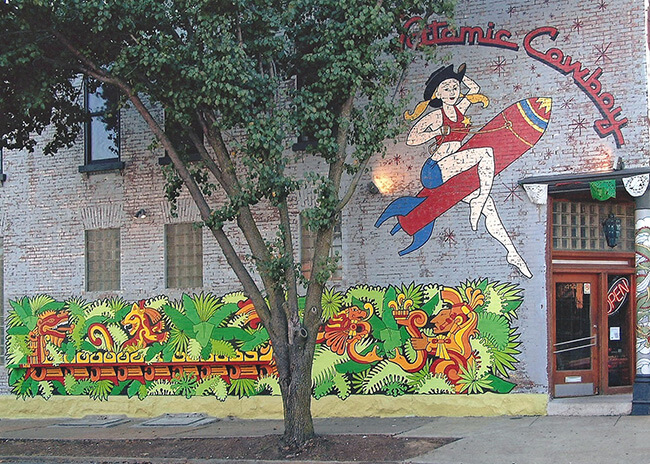Across the country, cities large and small are looking a little more colorful lately—and that’s not because of the changing seasons. Groups that aim to promote local talent and engage the community have been turning empty city walls into huge public canvases and the results of their labor can have a lasting effect on local neighborhoods.

“Murals build a sense of community,” muralist Grace McCammond told St. Louis Public Radio. “They make it welcoming and walkable and they make you want to go there.” McCammond’s first mural in the St. Louis, MO, neighborhood known as The Grove was commissioned fifteen years ago by a local property owner. It was so well received that soon other property owners wanted murals too. At the time, The Grove was a place most people avoided, but now it’s known as a local hotspot.
In Cincinnati, OH, ArtWorks employs teens to paint murals designed by local and nationally renowned artists—they are the largest employer of visual artists in the region. Since 1996, they have completed 90 murals ranging in style from trompe l’oeil to symbolism. “We strive to be the economic engine that empowers creatives to transform our region,” Tamara Harkavy, CEO and artistic director of ArtWorks told Opticos. ArtWorks also offers workshops covering important professional skills like money management and resume writing.
ArtWorks was inspired by Philadelphia, PA’s, Mural Arts Program, which under Executive Director Jane Golden sought to reorganize the raw artistic talent of the city’s graffiti artists. She went on to partner with city agencies to create programs that connect the process of muralism with art education, restorative justice, and behavioral health programs for Philadelphia’s youth population, inmates at area prisons and detention centers, and those suffering from trauma, mental illness, and addiction.
“While the end products—the works of public art—are always beautiful, their deeper value lies in the conversations we create, the connections we build, and the legacy of relationships we foster along the way, often with transformative results,” said Golden. “As Arlene Goldbard says, ‘The experience of art moves us from the everyday into the realm of possibility,’ and that goes for individuals, communities, systems, the city, and Mural Arts’ own practice.”
Nonprofit groups aren’t the only ones creating large-scale public art: The father-son team of Mike and John Manente launched a series of murals entitled “People of Oakland” that seeks to tell the stories of Oakland’s homeless. The two are billboard painters by trade, but use the traditional technique of pounce patterns to outline the image on the side of a building. (The time-lapse video above shows how the Manentes create their murals.) The temporary murals revolve on the old Victorian Haley Law Office building in downtown Oakland.
Oakland and Berkeley combined have almost 500 murals that range from informal street art to highly refined works commissioned by members of the community. Oakland murals in particular reflect community culture and pride—and some are just a little bit wacky. Dan Fontes has been painting murals in the Bay Area since the 1980s. One early mural titled “Animurals” shows a series of zebras under roaming the walls of the I-580 underpass near MacArthur Blvd. Another Fontes mural at the I-580 Harrison St. underpass features a series of giraffes. Both projects were sponsored by the Oakland Office of Community Development.
See our latest community designs and events on Twitter!